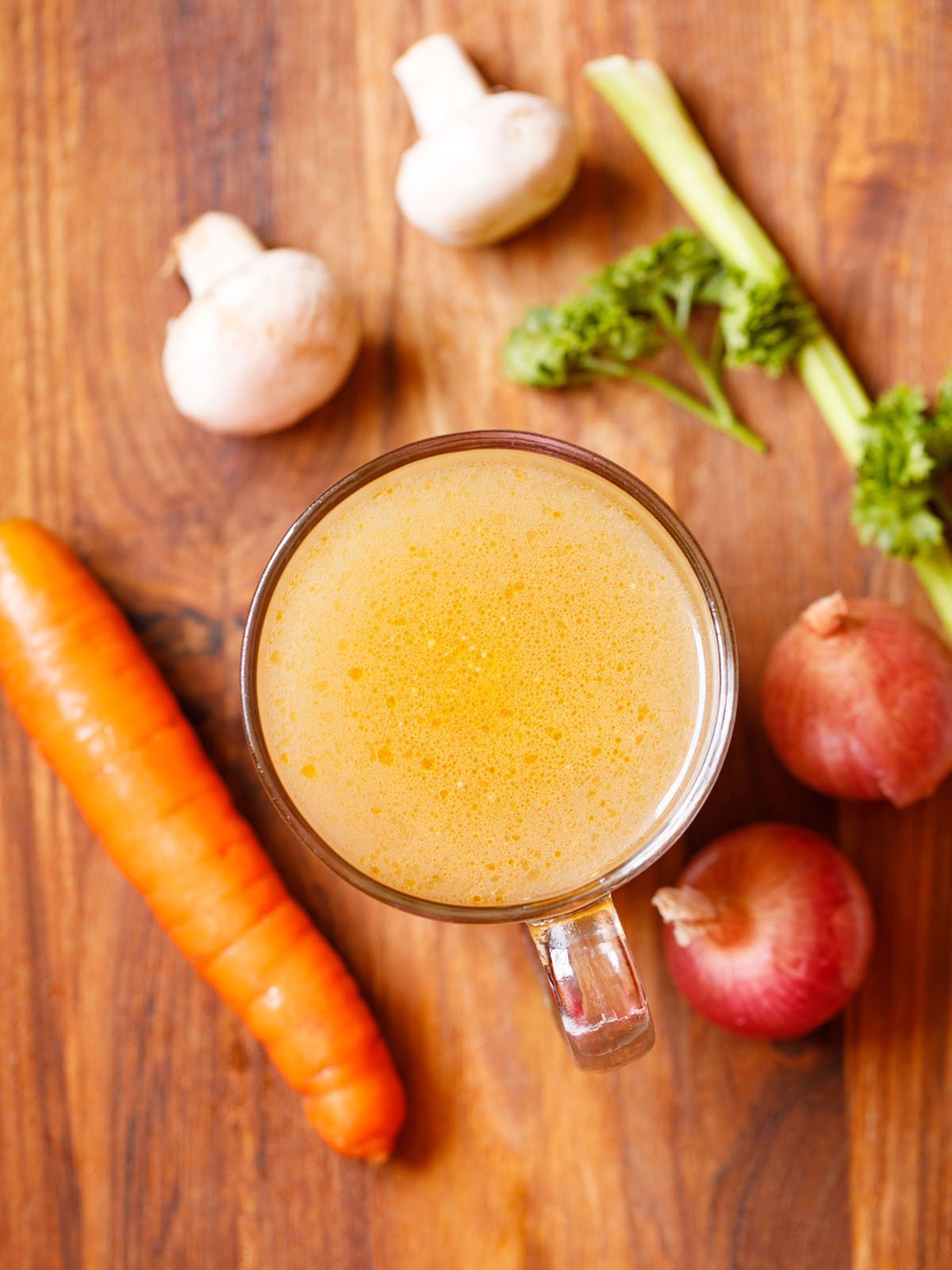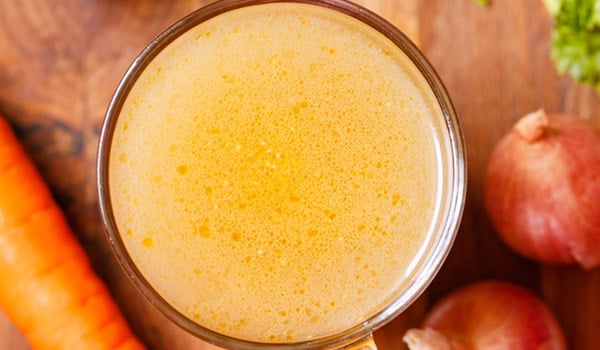Vegetable Stock is a savory, aromatic, and flavorful liquid made by gently simmering a variety of vegetables, spices, herbs, and seasonings in water, all without any animal products. This tried-and-true Vegetable Stock recipe is a true kitchen essential, effortlessly enhancing the flavor of everything from soups and curries to gravies and risottos. As a bonus, I have included instructions for preparing this vegetable stock both on the stovetop and in the Instant Pot.

About Vegetable Stock Recipe
I’ve been crafting this delightful homemade vegetable broth for many years, and I’m thrilled to share my recipe with you.
Infused with the aromas of fennel and coriander seeds, this vegetable broth adds a unique and delightful seasoning to any dish it graces.
If you cook as often as I do, you know the power of stock. Much more flavorful than water, vegetable stock can elevate a variety of recipes.
Almost any savory recipe that calls for water can be significantly improved by substituting stock. For instance, next time you prepare a pot of rice, try using this vegetable broth instead of water. The flavor boost will be remarkable!
What I love about this recipe is its simplicity. With just a few ingredients, minimal prep time, and a touch of patience, you can have a generous batch of savory goodness ready to go.
My vegetable stock recipe is also highly concentrated, meaning you don’t need to use much to impart a lot of flavor, and you can dilute it with water if desired.
I like to make a large batch of this veggie broth and freeze it in ice cube trays. These stock cubes are incredibly convenient for use in any recipe.
I use it for soups, curries, pulao, risotto, and gravies. Additionally, I enjoy warming a mugful whenever I’m feeling under the weather.
The essential ingredients for this recipe are easy to find: onion, celery, carrots, and garlic. From there, you can easily customize this vegetable broth to suit your preferences by incorporating your favorite herbs.
Is Vegetable Stock the Same as Vegetable Broth?
Yes, they are often used interchangeably! While I learned the term “vegetable broth” in culinary school, these days, people frequently refer to it as “vegetable stock” as well.
Technically, stocks are made with meat, while broths are made with vegetables. However, since most people don’t mind the distinction, neither do I! Feel free to use this delicious liquid in any recipe that calls for either stock or broth.
Vegetables to Include
The basic version of nearly any vegetable broth starts with the French trinity of onions, celery, and carrots. These are essential in a vegetable stock recipe.
However, you can easily mix things up by adding other vegetables such as:
- Tomatoes: Enhance acidity and give the stock a lovely hue.
- Corn cobs: Impart a delightful sweetness.
- Fennel bulb: Adds a lovely licorice-like flavor.
- Leeks: Provide a mild onion-like aroma.
- Parsnips: Contribute an earthy, sweet, and nutty flavor.
- Mushrooms (button, shiitake, or cremini): Add a rich umami flavor.
Tip: If you cook frequently, consider keeping a gallon-sized freezer bag for your vegetable scraps. The skins and root ends from garlic, onions, celery, carrots, and herb stems can all be tossed in. When the bag is full, you can use it to flavor your stock!
Vegetables to Avoid
Some vegetables should be avoided in your vegetable broth recipe, as they can make your stock bitter, cloudy, or slimy.
1. Watery Vegetables
Avoid adding watery vegetables like gourds to the stock, as they don’t contribute much flavor and may cloud or darken your stock.
- Zucchini
- Summer squash
- Okra
- Cucumber
- Eggplant
- Radishes
- Beets
2. Cruciferous Vegetables
It’s best to steer clear of cruciferous vegetables in a vegetable broth recipe, as they can impart a sulfurous flavor.
- Cauliflower
- Broccoli
- Cabbage
- Brussels sprouts
3. Starchy Vegetables
Starchy vegetables should also be avoided, as they can make your broth thick and cloudy.
- Potatoes
- Sweet potatoes
- Peas
How to Make Vegetable Stock
Preparation
1. Whether you’re making your stock on the stovetop or in the Instant Pot, the preparation for the vegetables remains the same. Rinse and roughly chop or slice carrots, tomatoes, onions, celery, and button mushrooms. Chop your herbs.
You will need the following proportions of vegetables and herbs:
- 1 to 1.25 cups chopped onions
- 1 cup chopped carrots
- 1 to 1.25 cups chopped button mushrooms
- ⅓ cup chopped tomatoes
- ⅓ cup chopped celery or 2 celery stalks (with or without leaves)
- ⅓ cup chopped parsley (both leaves and stems)
Cooking Stock on the Stovetop
2. Heat oil in a large pot or saucepan. Add lightly crushed garlic cloves (with their peels) and a small to medium bay leaf. Sauté for a few seconds without browning the garlic to extract maximum flavor.
Tip: You can skip the oil if you prefer a lighter stock.
3. Add the chopped mushrooms, onions, tomatoes, and carrots.
4. Mix and sauté for a minute.
5. Add the chopped parsley and celery. Quick note: You can include celery leaves in this recipe!
6. Add the spices:
- 1 tablespoon coriander seeds
- 2 teaspoons fennel seeds
- 3 cloves
- ½ teaspoon black peppercorns
- 1 to 1.5 inches of true cinnamon (Ceylon cinnamon)
7. Add 4 cups of water. Mix and stir well.
8. Cover and simmer for 30 to 45 minutes on low to low-medium heat.
Cooking in the Instant Pot
9. The Instant Pot version of my stock uses the same ingredients and quantities as the stovetop version, with the exception of oil and more water. Use 6 cups of water instead of 4 when making this in the Instant Pot.
10. Place the chopped veggies, herbs, and spices in the steel insert of a 6-quart Instant Pot.
11. Add water and stir well.
12. Secure and lock the lid on the Instant Pot. Turn the steam release valve to the ‘sealing position’ to build pressure.
Pressure cook on high for 15 minutes. Allow the pressure to release naturally and cool at room temperature.
Straining Stock Liquid
13. Regardless of whether you used the stovetop or Instant Pot method, strain your stock. Allow it to cool completely at room temperature before straining.
14. Strain through a fine mesh strainer, mashing the veggies lightly if desired.
15. I love to pour the stock into ice cube trays and freeze them for easy use in future recipes.
How to Use Vegetable Broth
This flavorful broth can be utilized in countless ways. Use it to create your favorite soups, stews, curries, gravies, and more! Any recipe that calls for vegetable or chicken broth will benefit from your homemade stock.
How to Store Veg Stock
This homemade vegetable stock can be stored in a lidded container in the refrigerator for up to a week. Alternatively, you can freeze some in ice cube trays. Once frozen solid, transfer them to a bag for easy access.
If you prefer to store your homemade vegetable broth in the freezer without using ice cube trays, freezer bags work well too.
How to Get the Most Flavor from Your Vegetable Broth
The key to any broth or stock recipe is slow simmering. Low heat allows the flavors from the vegetables to develop over time. For this recipe, simmer for up to 45 minutes.
Be careful not to boil the stock, as this can break down the vegetables and make it difficult to strain out the solids.
Lastly, ensure the stock cools completely before straining to maximize flavor extraction and maintain the integrity of the vegetables.
How to Customize the Flavor of This Veggie Stock?
I recommend keeping the celery, carrots, and onions as a base for your broth.
While you can skip the fennel and coriander seeds, both add wonderful flavor. This is a tip I learned from my mother, who includes these seeds in her stock for Yakhni Pulao, making it the best I’ve ever tasted.
If you love the taste of coriander (cilantro), feel free to substitute fresh coriander leaves for the parsley. Using different herbs and spices is a fantastic way to personalize your flavor profile.
You can also add ingredients to change the flavor. For instance, tomatoes will add acidity, mushrooms or nutritional yeast will impart umami, and corn cobs will contribute sweetness.
Adding Dried Shiitake Mushrooms
Rinse 6 to 7 dried shiitake mushrooms thoroughly in fresh water. Soak them for one to two hours in 2 cups of warm water.
Once softened, add them along with the soaking water to the remaining vegetables. If cooking on the stovetop, add 2 cups of water, or 4 cups if using the Instant Pot.
Expert Tips
- Vegetables to include: Onions, carrots, tomatoes, fennel bulb, corn cobs, leeks, parsnips, and edible fungi such as button, shiitake, and cremini mushrooms are ideal for vegetable stock.
- Vegetables to avoid: Refrain from using zucchini, summer squash, eggplant, okra, radishes, beetroot, cauliflower, broccoli, cabbage, Brussels sprouts, potatoes, sweet potatoes, and green peas.
- Dried shiitake mushrooms: If using shiitake mushrooms, rinse 6 to 7 of them thoroughly in fresh water. Soak for 1 to 2 hours in 2 cups of warm water. When soft, add them along with the soaking water to the remaining vegetables. Adjust water as needed based on cooking method.
- Spices and herbs: For a beautifully flavored stock, consider adding fennel seeds or coriander. While optional, it’s important to include celery. You can customize your stock with your preferred herbs and spices, and adding nutritional yeast can provide an umami twist.
- Cloudy stock: If your vegetable stock turns out cloudy, don’t worry! Simply strain it twice using a fine strainer lined with cheesecloth or muslin.
- Storage: Refrigerate the stock in a container with a lid for about 7 days. For freezing, pour it into ice cube trays and once frozen, transfer to a bag for easy access. Alternatively, you can use freezer bags.
FAQs
I prefer my stock to be concentrated for maximum flavor. However, you can easily dilute it with more water to suit your taste.
After making the stock, the vegetables will have given up most of their flavor and will become soft and mushy. I don’t recommend using them in recipes, but they are great for composting!
Absolutely! Simply add your vegetables, herbs, spices, and 6 cups of water to the crockpot and let it simmer on low for 8 to 9 hours.





